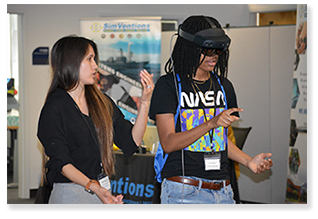Faculty Advisor/Mentor
Yiannis Papelis
Location
Virginia Modeling, Analysis and Simulation Center, Room 1201
Conference Title
Modeling, Simulation and Visualization Student Capstone Conference 2023
Conference Track
General Sciences & Engineering
Document Type
Paper
Abstract
This paper presents a probabilistic approach to quantifying interceptability of an interaction scenario designed to test collision avoidance of autonomous navigation algorithms. Interceptability is one of many measures to determine the complexity or difficulty of an interaction scenario. This approach uses a combined probability model of capability and intent to create a predicted position probability map for the system under test. Then, intercept-ability is quantified by determining the overlap between the system under test probability map and the intruder’s capability model. The approach is general; however, a demonstration is provided using kinematic capability models and an odometry-based intent model.
Keywords:
Evaluation metrics, Avoid-ability, Simulation
Start Date
4-20-2023
End Date
4-20-2023
Recommended Citation
Hargis, Benjamin E. and Papelis, Yiannis E., "Statistical Approach to Quantifying Interceptability of Interaction Scenarios for Testing Autonomous Surface Vessels" (2023). Modeling, Simulation and Visualization Student Capstone Conference. 3.
https://digitalcommons.odu.edu/msvcapstone/2023/sciencesandengineering/3
DOI
10.25776/v5je-dd12
Included in
Artificial Intelligence and Robotics Commons, Computational Engineering Commons, Navigation, Guidance, Control and Dynamics Commons, Probability Commons, Statistical Models Commons
Statistical Approach to Quantifying Interceptability of Interaction Scenarios for Testing Autonomous Surface Vessels
Virginia Modeling, Analysis and Simulation Center, Room 1201
This paper presents a probabilistic approach to quantifying interceptability of an interaction scenario designed to test collision avoidance of autonomous navigation algorithms. Interceptability is one of many measures to determine the complexity or difficulty of an interaction scenario. This approach uses a combined probability model of capability and intent to create a predicted position probability map for the system under test. Then, intercept-ability is quantified by determining the overlap between the system under test probability map and the intruder’s capability model. The approach is general; however, a demonstration is provided using kinematic capability models and an odometry-based intent model.

